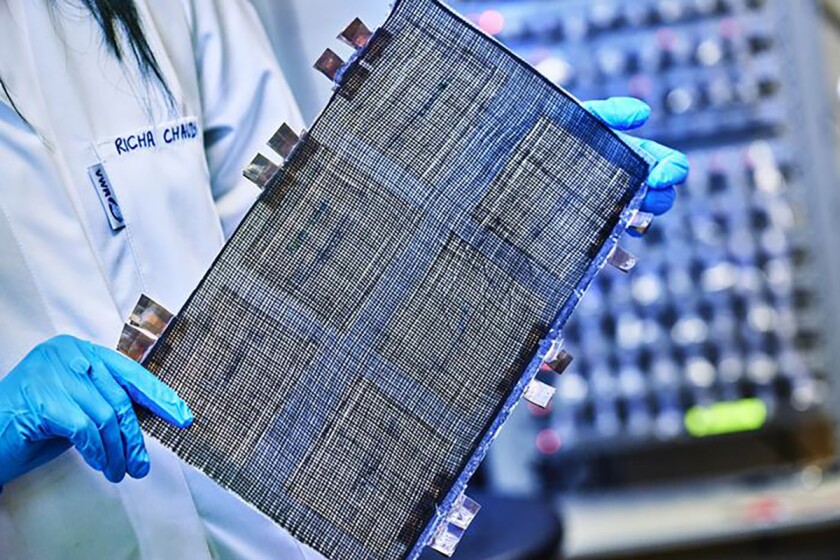
Posted on 09/15/2024 1:08:02 PM PDT by Red Badger
When cars, planes, ships or computers are built from a material that functions as both a battery and a load-bearing structure, the weight and energy consumption are radically reduced. A research group at Chalmers University of Technology in Sweden is now presenting a world-leading advance in so-called massless energy storage – a structural battery that could halve the weight of a laptop, make the mobile phone as thin as a credit card or increase the driving range of an electric car by up to 70 percent on a single charge.

image:
Researchers at Chalmers University of Technology have succeeded in creating a battery made of carbon fibre composite that is as stiff as aluminium and energy-dense enough to be used commercially. When cars, planes, ships or computers are built from a material that functions as both a battery and a load-bearing structure, the weight and energy consumption are radically reduced.
==============================================================================
"We have succeeded in creating a battery made of carbon fibre composite that is as stiff as aluminium and energy-dense enough to be used commercially. Just like a human skeleton, the battery has several functions at the same time," says Chalmers researcher Richa Chaudhary, who is the first author of a scientific article recently published in Advanced Materials.
Research on structural batteries has been going on for many years at Chalmers, and in some stages also together with researchers at the KTH Royal Institute of Technology in Stockholm, Sweden. When Professor Leif Asp and colleagues published their first results in 2018 on how stiff, strong carbon fibres could store electrical energy chemically, the advance attracted massive attention. The news that carbon fibre can function as electrodes in lithium-ion batteries was widely spread and the achievement was ranked as one of the year's ten biggest breakthroughs by the prestigious Physics World.
Lower weight requires less energy
Since then, the research group has further developed its concept to increase both stiffness and energy density. The previous milestone was reached in 2021 when the battery had an energy density of 24 watt-hours per kilogramme (Wh/kg), which means roughly 20 percent capacity of a comparable lithium-ion battery. Now it's up to 30 Wh/kg. While this is still lower than today's batteries, the conditions are quite different. When the battery is part of the construction and can also be made of a lightweight material, the overall weight of the vehicle is greatly reduced. Then not nearly as much energy is required to run an electric car, for example.
"Investing in light and energy-efficient vehicles is a matter of course if we are to economise on energy and think about future generations. We have made calculations on electric cars that show that they could drive for up to 70 percent longer than today if they had competitive structural batteries," says research leader Leif Asp, who is a professor at the Department of Industrial and Materials Science at Chalmers.
When it comes to vehicles, of course, there are high demands on the design to be sufficiently strong to meet safety requirements. There, the research team's structural battery cell has significantly increased its stiffness, or more specifically, the elastic modulus, which is measured in gigapascal (GPa), from 25 to 70. This means that the material can carry loads just as well as aluminium, but with a lower weight.
"In terms of multifunctional properties, the new battery is twice as good as its predecessor – and actually the best ever made in the world," says Leif Asp, who has been researching structural batteries since 2007.
Several steps towards commercialisation
From the start, the goal was to achieve a performance that makes it possible to commercialise the technology. In parallel with the fact that the research is now continuing, the link to the market has been strengthened – through the newly started Chalmers Venture company Sinonus AB, based in Borås, Sweden.
However, there is still a lot of engineering work to be done before the battery cells have taken the step from lab manufacturing on a small scale to being produced on a large scale for our technology gadgets or vehicles.
"One can imagine that credit card-thin mobile phones or laptops that weigh half as much as today, are the closest in time. It could also be that components such as electronics in cars or planes are powered by structural batteries. It will require large investments to meet the transport industry's challenging energy needs, but this is also where the technology could make the most difference," says Leif Asp, who has noticed a great deal of interest from the automotive and aerospace industries.
More about: Research and structural batteries Structural batteries are materials that, in addition to storing energy, can carry loads. In this way, the battery material can become part of the actual construction material of a product, which means that much lower weight can be achieved on, for example, electric cars, drones, handheld tools, laptops and mobile phones.
The latest advances in this area have been published in the article Unveiling the Multifunctional Carbon Fibre Structural Battery in the journal Advanced Materials. The authors are Richa Chaudhary, Johanna Xu, Zhenyuan Xia and Leif Asp at Chalmers University of Technology.
The developed battery concept is based on a composite material and has carbon fibre as both the positive and negative electrodes – where the positive electrode is coated with lithium iron phosphate. When the previous battery concept was presented, the core of the positive electrode was made of an aluminium foil.
The carbon fibre used in the electrode material is multifunctional. In the anode it acts as a reinforcement, as well as an electrical collector and active material. In the cathode it acts as a reinforcement, current collector, and as a scaffolding for the lithium to build on. Since the carbon fibre conducts the electron current, the need for current collectors made of copper or aluminium (for example), is reduced, which reduces the overall weight even further. Nor are any so-called conflict metals such as cobalt or manganese required in the chosen electrode design.
In the battery, the lithium ions are transported between the battery terminals through a semi-solid electrolyte, instead of a liquid one, which is challenging when it comes to getting high power and for this more research is needed. At the same time, the design contributes to increased safety in the battery cell, through reduced risk of fire.
The research has been funded by the Wallenberg Initiative Materials Science for Sustainability (WISE) programme.
DOI
10.1002/adma.202409725
Article Title
Unveiling the Multifunctional Carbon Fibre Structural Battery
Article Publication Date
10-Sep-2024
https://newatlas.com/technology/carbon-fiber-structural-battery-ev-range/
Those would be truly disposable cars.
Is this “right around the corner”?
Sharpee labeled lab coat leads me to remember the previous 9,000 similar technology announcements that go nowhere.
Deep in the article...
“However, there is still a lot of engineering work to be done before the battery cells have taken the step from lab manufacturing on a small scale to being produced on a large scale for our technology gadgets or vehicles.”
Yep, just around the corner... just like power from fusion.
Crime family boss: "Hey, so we can dispose of the dead guys in the trunks at the same time. Progress. Two things at one time."
And exactly HOW MUCH does this spiffy new battery cost???
$100, $10,000 $100,000 EACH?
Until the cost is minimal this is nothing more than a spiffy lab experiment that already costs Millions of $$$$.
This is TRL 3-4 at best. /Spit
And the cars will fly and recharging will be free by using fusion generation of electricity!
1, Energy resents being confined. The more densely you compact it, the more violence it will wreak if/when it escapes.
2. They’re still peddling the LIE that there’s anywhere on earth that has an electrical power generation and delivery infrastructure with sufficient capacity to spare that it could support a significant portion of ice ICE automobiles being replaced with battery-only EVs.
The E-Cat cold fusion generator will render this worthless.
Yada yada yada, where is that cold fusion we were promised, a battery still has to be charged , where are those electrons coming from?
The previous milestone was reached in 2021 when the battery had an energy density of 24 watt-hours per kilogramme (Wh/kg), which means roughly 20 percent capacity of a comparable lithium-ion battery. Now it's up to 30 Wh/kg.
Please note they are claiming Wh/kg, NOT kWh/kg. Next to nothing. One kg of this battery will move your car perhaps 12 yards, while one kg of diesel fuel will move your car 12 miles.
Choose wisely.
(The above is not an exact calculation - as always in cases such as this one I will look at orders of magnitude instead of significant figures after the decimal point...you will either understand that or not.)
(Is this “right around the corner”?)
Two weeks
Just ahead
safe AND effective

I have doubts as to whether many of us will live to see such a commercial development.
Military first, I expect. Imagine the application for drones...
I can see the usefulness in certain cases
But if you make it structural, what happens in a crash...
“Pure Energy!”
More bull feces from the EV industry. What happens when the battery no longer holds a charge? You throw away the whole vehicle? AND ... where the electricity comes from is still a big problem since batteries only store electricity produced somewhere else They’re a scam like the ethanol as a motor fuel fraud. Only positive effect of ethanol is to enrich big agricultural conglomerates like Archer Daniels Midlands at the expense of the motoring public.
The more energy the bigger the arc when it shorts.
“massless energy storage”
A laptop made entirely of photons! Wouldn’t it be so bright you couldn’t even look at it?
Disclaimer: Opinions posted on Free Republic are those of the individual posters and do not necessarily represent the opinion of Free Republic or its management. All materials posted herein are protected by copyright law and the exemption for fair use of copyrighted works.